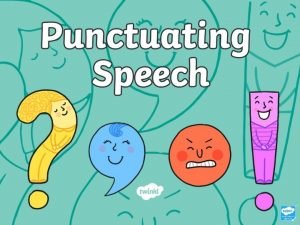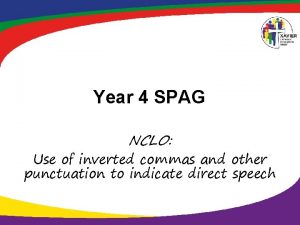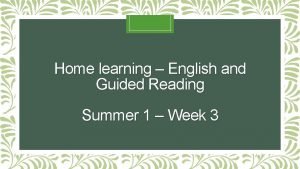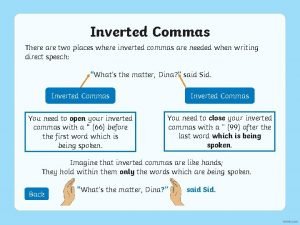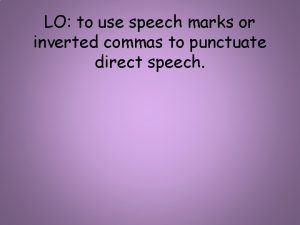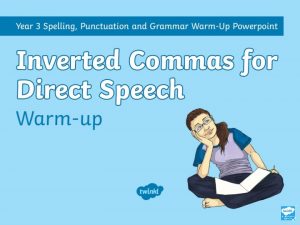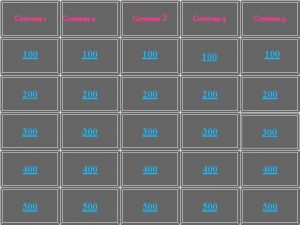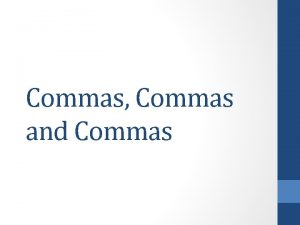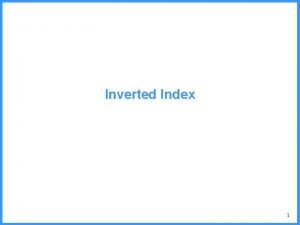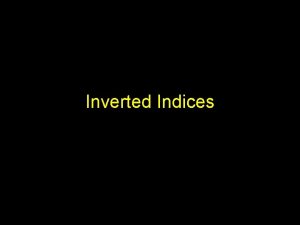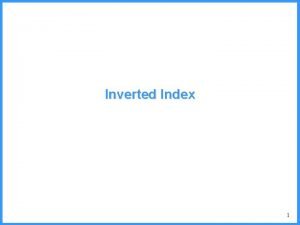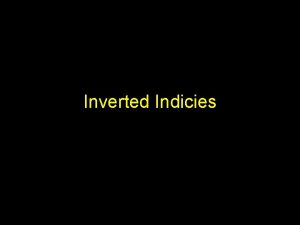Inverted Commas Inverted Commas Inverted commas are also









- Slides: 9

Inverted Commas “

Inverted Commas �Inverted commas are also known as speech marks. �They are used to show when someone is speaking. �Although it may look complicated, by following just a few simple rules you can become an expert at punctuating direct speech.

Rules for Punctuating Direct Speech 1. Place “ ” around the words which are spoken. 2. Use a capital letter at the start of a speech sentence (even if it is in the middle of another sentence). 3. Before you close your inverted commas use a comma, question mark or exclamation mark to separate what was said from the speaker. 4. If a new person speaks, start a new line.

For example: Kevin replied, “No, definitely not. ” ‘No’ is capitalised because it is the start of the speech sentence. “Should we tell the humans we can speak English? ” asked Stuart. The punctuation placed before closing the inverted commas is a ? as Stuart asked a question

For example: “I’ll race you there!” said Isla. Despite coming after an ! , said is not capitalised. “You’ll win then, ” murmured Emery, “you’re much faster than I am. ” ‘you’re’ doesn’t need a capital letter because it is not the start of the speech sentence.

Punctuating Direct Speech Can you punctuate the speech in these sentences correctly? �What time are we going out asked Zoe. “What time are we going out? ” asked Zoe. �Yasmin shouted look out Yasmin shouted, “Look out!” �Besides said Sam thoughtfully what was she doing there anyway “Besides, ” said Sam thoughtfully, “what was she doing there anyway? ” Remember: Put inverted commas around what the speaker says, start each speech sentence with a capital letter and place a piece of punctuation before closing your inverted commas.

Reporting Clause

Reporting Clause �Direct speech will almost always need a reporting clause. �A reporting clause tells the reader who the speaker was and how they spoke. �For example: “I came 1 st!” shouted Frank excitedly. This is a reporting clause – it tells you that Frank was our speaker and he was shouting excitedly.

Reporting Clause �A reporting clause can come before, after or split the direct speech. For example: Location Sentence Before Dan asked hungrily, “Do you know what time lunch is? ” After “Do you know what time is lunch is? ” Dan asked hungrily. Embedded “Do you know, ” Dan asked hungrily, “what time lunch is? ” �Varying the location of the reporting clause keeps your writing interesting for the reader.

